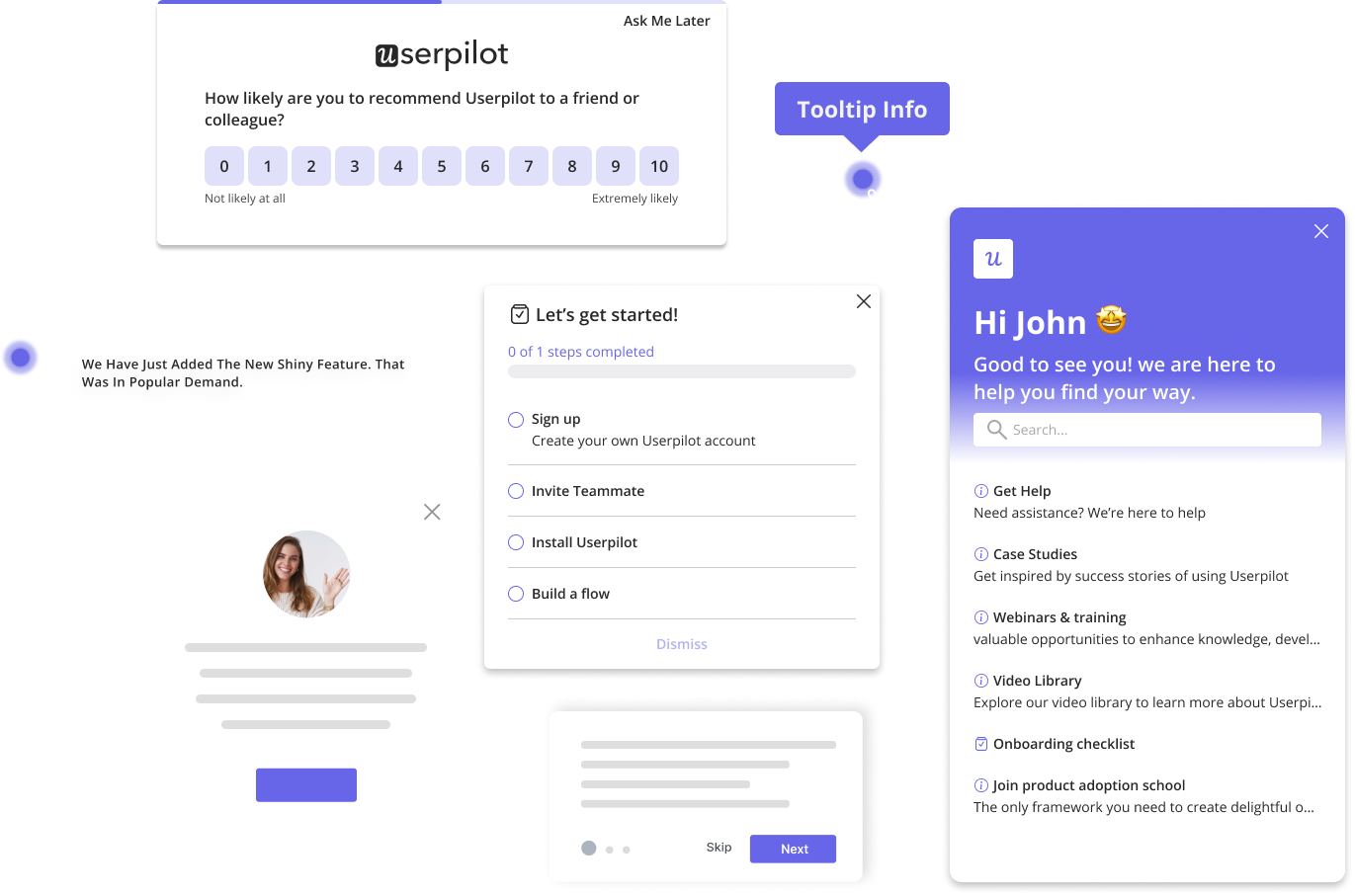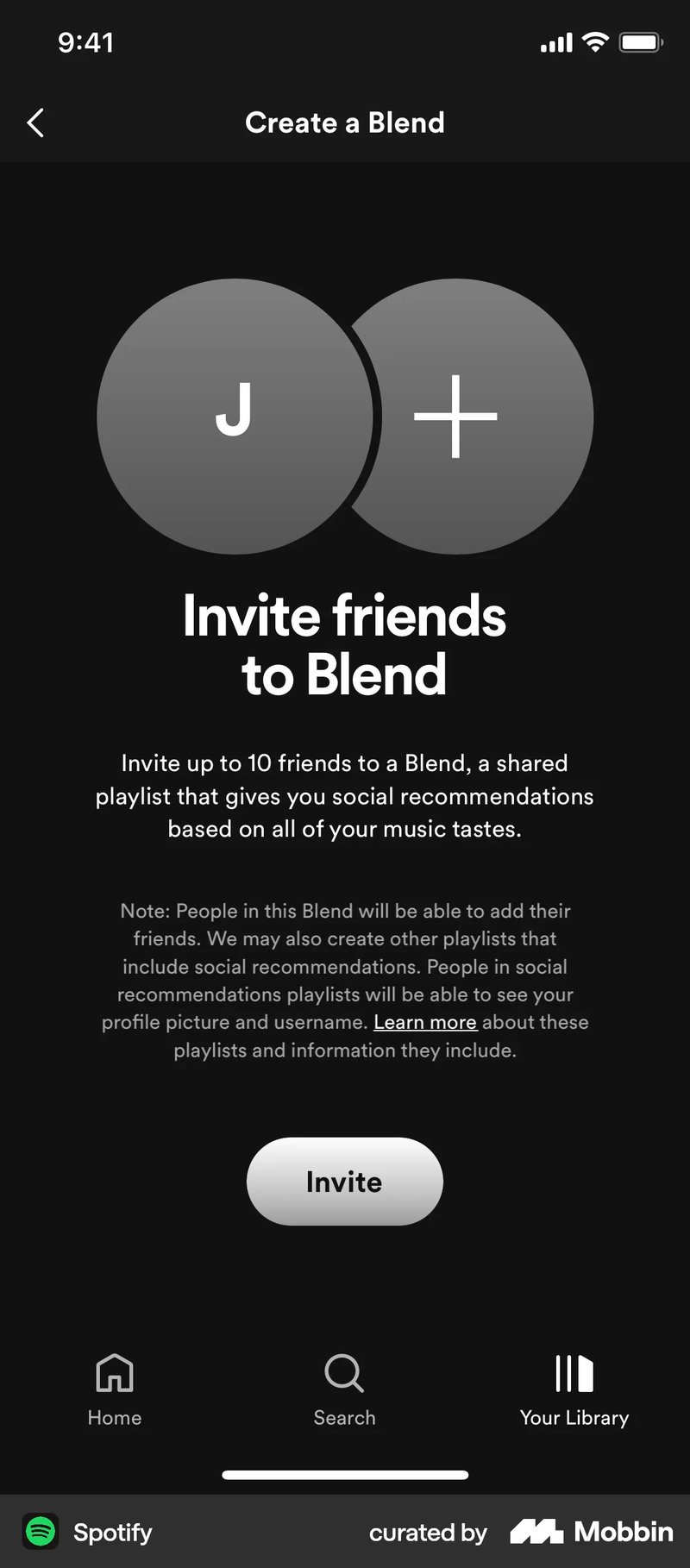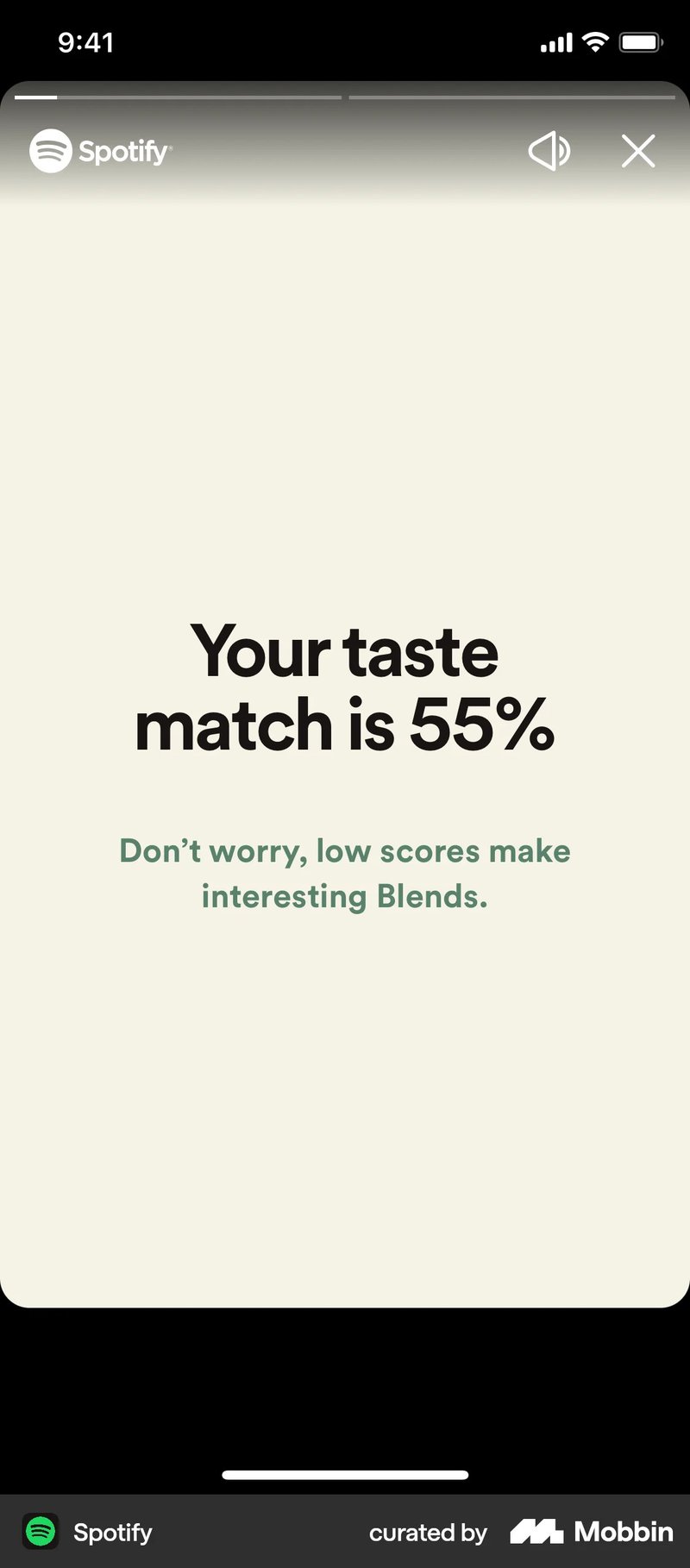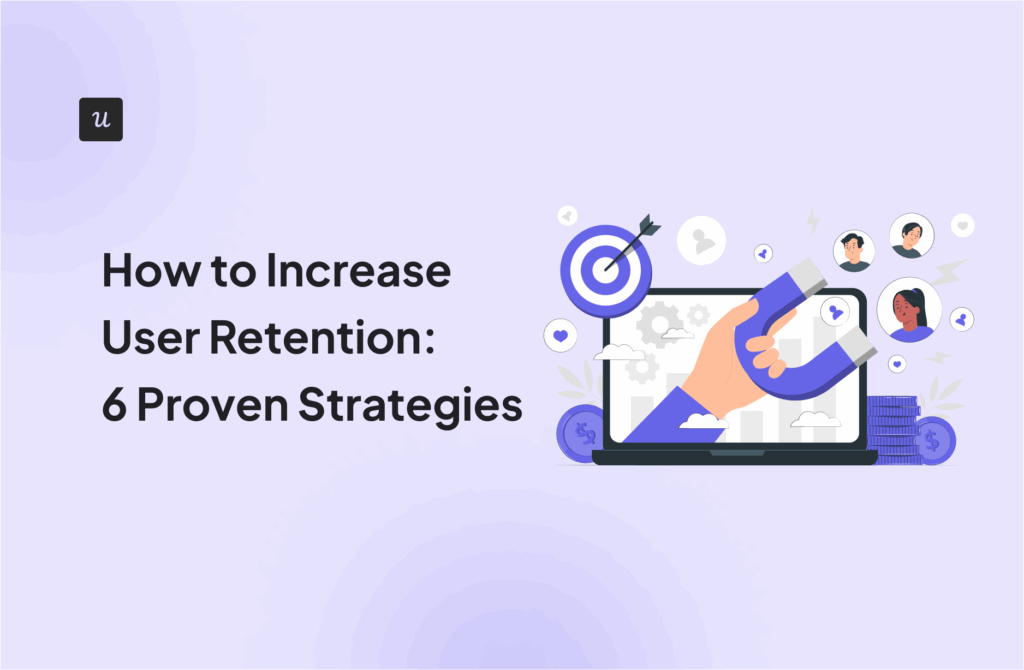
When it comes to mobile app retention, you can’t expect to retain most users just because your product is good.
Mobile is competitive. Only about 13% of business apps succeed (even less for consumer apps), and their average retention rate per month is less than 3%.
In my experience as a customer success manager, you must incentivize retention deliberately. You must learn the mobile retention best practices to prevent too many users from leaving.
So, let’s explore how you can improve the retention in your mobile app with Userpilot’s brand new mobile features:
Try Userpilot Now
See Why 1,000+ Teams Choose Userpilot

What is mobile app retention?
Mobile app retention is the percentage of users who continue using a mobile app after their first install over a defined period of time. With Day 1, Day 7, and Day 30 being common benchmarks.
It’s a key performance metric that reflects how well your app delivers ongoing value to users. And not just during the initial experience, but weeks and even months down the line.
Why and when should you increase app retention rate?
Retention is also a constant, evolving challenge because user expectations, app experiences, and market standards are always changing.
So, to be honest, you should always be thinking about how to improve your mobile app’s retention rate. It’s not a one-time project or something you set and forget.
However, it’s one of those metrics that benefits almost every aspect of your business. For example:
- Boosts your ROI. It’s significantly cheaper to retain users than to drive user acquisition.
- Improves lifetime value. Retained users stick around longer and tend to spend more.
- Strengthens product-market fit. High retention often means your app is delivering meaningful value.
- Drives organic growth. Loyal users are more likely to refer friends and leave positive reviews.
- Gives you more product insight. Retained users generate more behavioral data you can learn from.
Now, while I wouldn’t say there’s a “when” to AA (as I said, it should be ongoing), there are a few moments where it becomes especially critical:
- After a major app update. You need to re-engage users and make sure new features stick.
- During periods of churn or usage decline. A drop in usage signals it’s time to investigate and take action on retention.
- When you’re scaling growth efforts. Retention ensures that growth isn’t just a leaky bucket.
At the end of the day, high retention means you’re building something people genuinely want to use. Keep that as the goal.
8 Strategies and best practices to increase mobile app user retention
Every interaction plays a role in shaping how users feel about your app and whether they’ll stick with it.
That said, let’s go over eight proven strategies we’ve seen work across industries, as well as how you can implement many of them with Userpilot:
#1 Improve your in-app onboarding experience
This isn’t news, but the first few minutes after a user installs your app are make-or-break.
This means a great onboarding is your chance to deliver a quick “Aha!” moment, the point where someone sees the value your app provides and understands how to get it again.
For this, take a moment to think about how you can take the onboarding process more seriously. And rather than seeing it as a task to check off your to-do list, make an honest attempt to make it valuable to new users.
Here’s how to make that onboarding experience work:
- Simplify your sign-up flows. The fewer steps and required inputs in your signup flow, the better. Let users explore value before they commit to lengthy forms.
- Use onboarding surveys to personalize the journey. Apps like YNAB ask new users about their goals upfront and then tailor the experience accordingly.
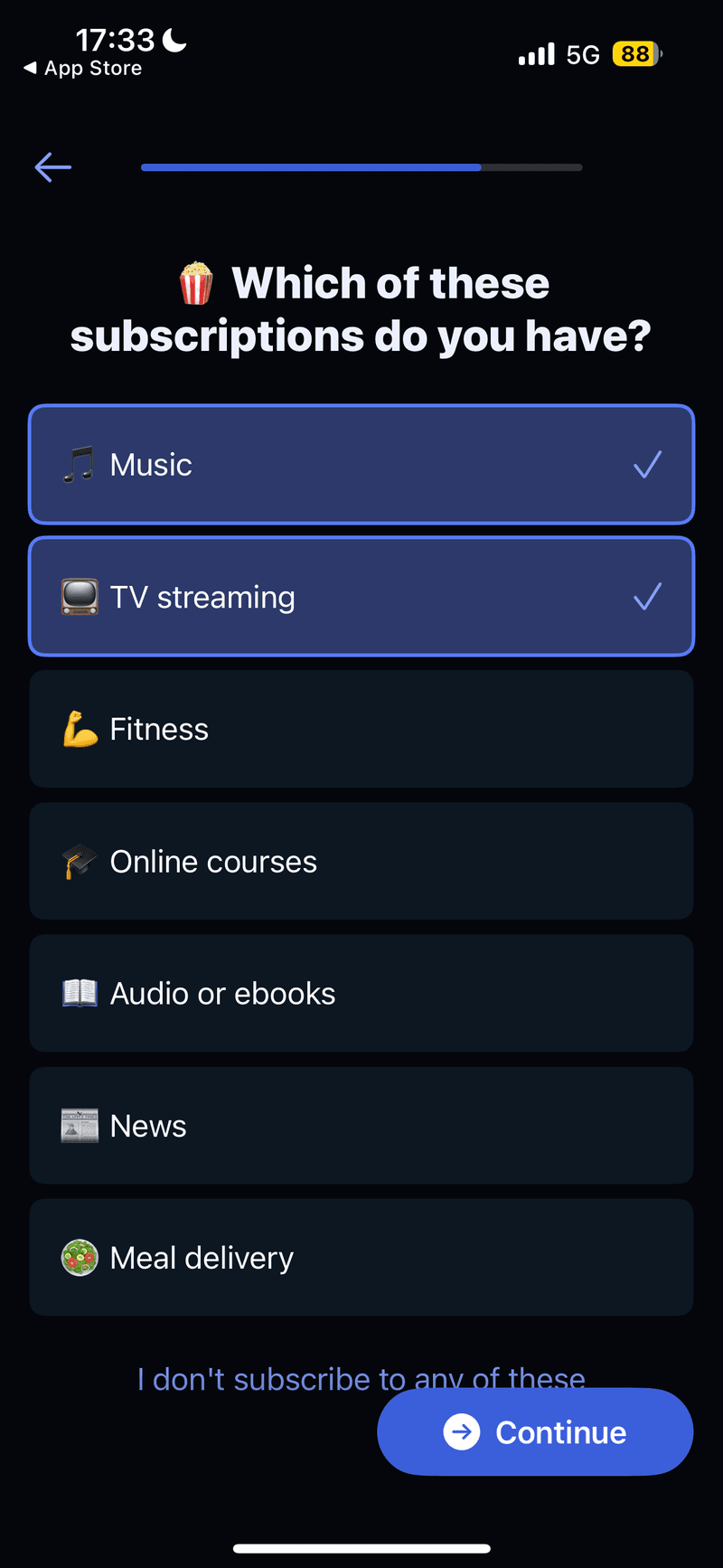
- Guide users with contextual UX patterns. Combining slideouts, carousels, and checklists can help users progress without being overwhelmed. These in-app flows should feel like a helpful companion, not a tutorial dump.
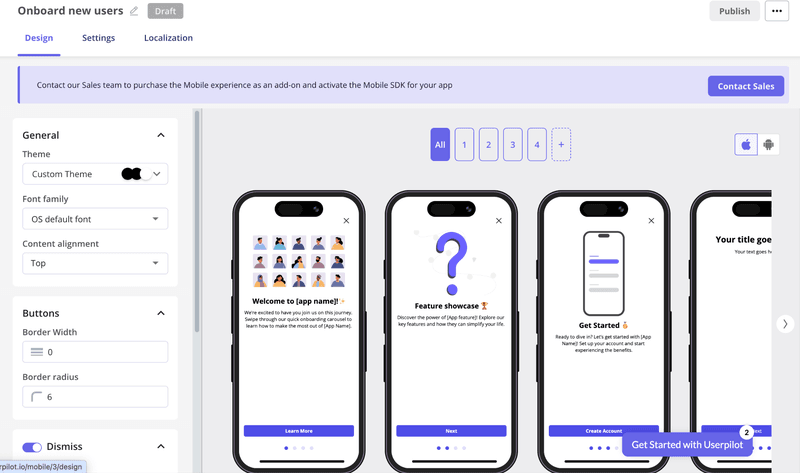
#2 Leverage in-app messages to drive user engagement
Once a user is in your app, it’s the perfect moment to guide, educate, or re-engage them with in-app messages.
However, it is not just any message; the key is to make these messages timely, relevant, and behavior-based. Think of how Spotify notifies you about a new release from one of your favorite artists, it must be thoughtful and useful for your user’s mobile experience.
Here are a few ways to use in-app messaging effectively:
- Announce updates or new features right when users are most likely to benefit from them.
- Deliver time-sensitive promotions or offers to drive urgency and action.
- Celebrate user milestones (like completing a challenge or hitting a streak) to reinforce positive behaviors.
- Trigger helpful nudges if users are stuck or dropping off at key moments.
With Userpilot, for instance, you can create and target in-app messages based on user behavior, device type, or past interactions (no engineering time is required). Whether you’re onboarding, upselling, or educating, you can do it natively inside your mobile experience.
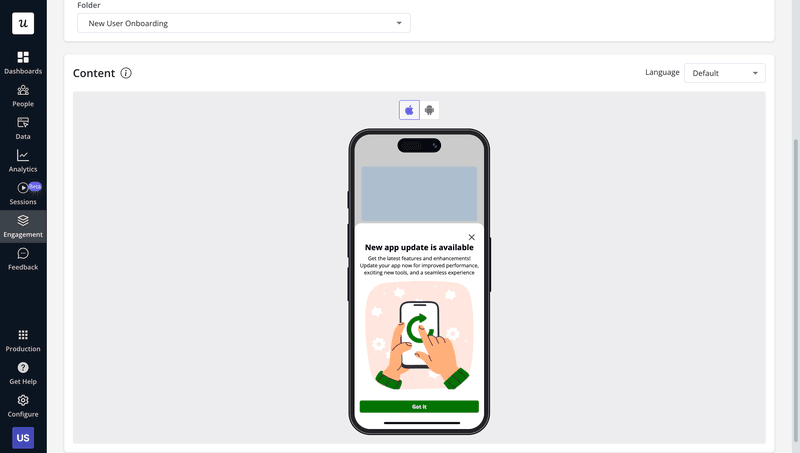
#3 Personalize push notifications based on user behavior
Push notifications are indeed one of the most powerful tools in your retention toolkit.
The problem? Too many apps send generic, irrelevant, or poorly timed notifications… and that’s a fast track to getting muted (or worse, uninstalled).
The key is personalization, tailoring your push notifications based on what users do in your app.
Here’s how to make that happen:
- Segment your users. Not everyone needs the same message. Separate users based on behavior, preferences, or lifecycle stage.
- Use different types of push notifications. Think of reminders for unfinished actions, alerts for limited-time offers, updates about new content or features, or even re-engagement nudges after inactivity.
- Incorporate geo-targeting. Timing a message to match the user’s local time zone or region-specific event will increase its visibility.
In Userpilot, we’re rolling out push notification capabilities for mobile. This means you’ll soon be able to craft, personalize, and target these messages directly within your app (no third-party platform hopping needed).
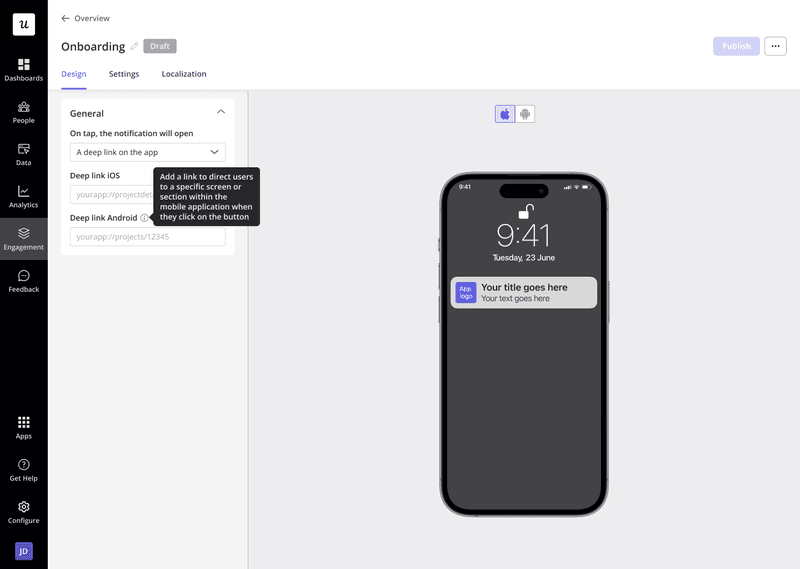
#4 Use gamification to foster habit formation among existing users
Gamification isn’t just about turning your app into a game but about leveraging dopaminergic behavior loops to get users back to your app every day.
This works perfectly for apps that are used daily. Think of Duolingo, Strava, and Todoist; they all have nailed gamification because they tap into our natural desire for progress, rewards, and a little healthy competition.
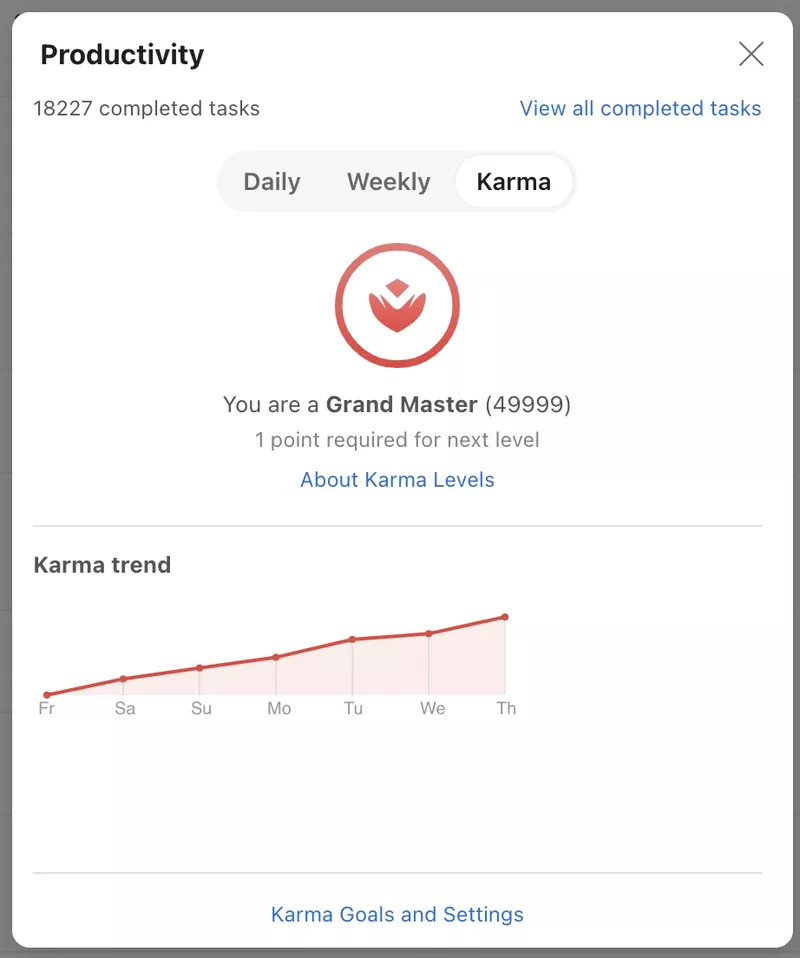
Here are different gamification elements you can add:
- Create visible progress loops. Streaks, progress bars, and achievement tracking help users feel momentum.
- Incorporate rewards and incentives. Whether it’s points, badges, or unlockables, any small win triggers dopamine (and dopamine builds habits).
- Use leaderboards or social comparison. This works especially well in fitness, education, or productivity apps.
- Keep it optional and light. Gamification should enhance the experience rather than pressure your users into working.
#5 Build loyalty and reward engagement through loyalty programs
If your app relies on regular purchases or frequent engagement, a well-designed loyalty program can be a game-changer for retention.
Apps like Starbucks, Klarna, and Sephora have shown that rewarding repeat behavior not only drives more usage but also makes users feel valued.
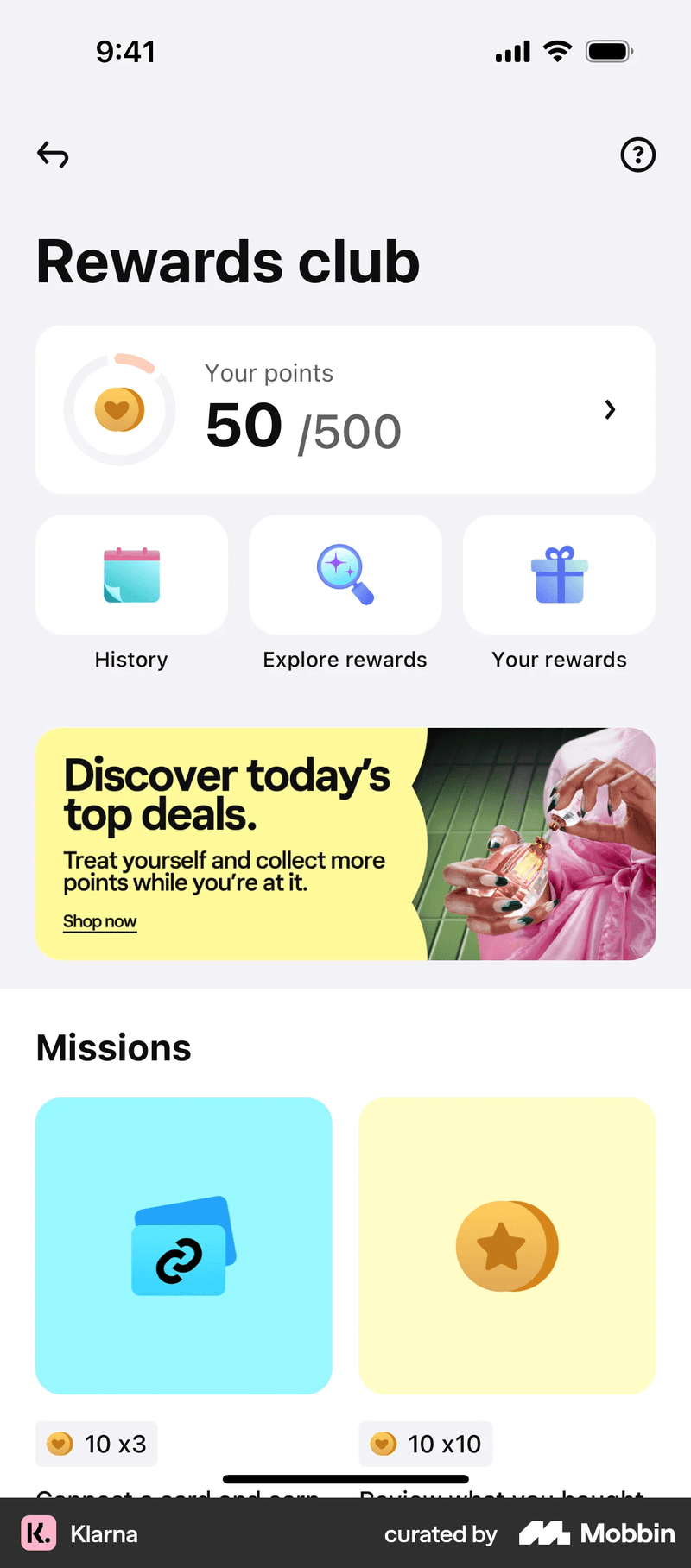
So here’s what to keep in mind when building loyalty programs:
- Reward meaningful actions. Points or perks should be tied to behaviors like purchases, referrals, or consistent usage.
- Offer tiered membership levels. Higher tiers unlock exclusive rewards, giving users a reason to level up and become monthly active users.
- Keep it simple and transparent. Users should instantly understand how to earn rewards and what those rewards are worth. Just like Klarna does:
- Personalize promotions. Target users with exclusive offers, birthday rewards, or “double points” events based on their habits.
#6 Collect feedback to improve your mobile app retention
You can call this a tired argument, but user feedback will always be one of the most direct and effective ways to improve retention.
It helps you spot friction, prioritize fixes, and deliver features your users want. Plus, even more importantly, acting on feedback shows users you’re listening and builds trust over time.
Here’s how to build a strong feedback loop:
- Use in-app surveys to capture real-time sentiment. Don’t wait for an app store review to learn from your users. Instead, ask for feedback while users are actively engaged with your app.
- Make it contextual. Trigger microsurveys based on specific actions, moments of success, or points of friction.
- Close the feedback loop. Acknowledge suggestions, communicate changes, and follow up when you roll out improvements.
- Track trends over time. User feedback isn’t just about individual comments, it’s about spotting patterns and acting on them strategically.
We just implemented in-app feedback for mobile apps in Userpilot. This means there’s no need to waste dev time on launching surveys, targeting surveys to specific user segments, and building continuous feedback loops that move the needle on retention.
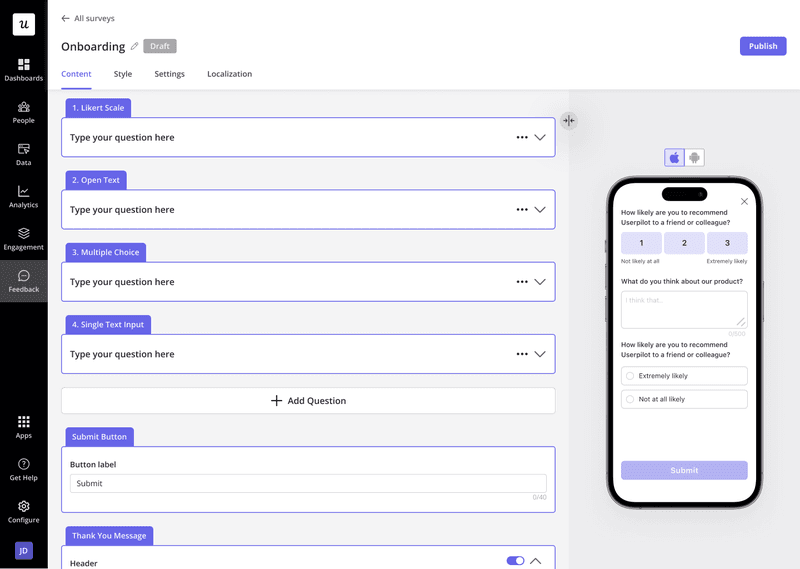
#7 Implement a robust in-app help and support system
No matter how intuitive your app is, users will eventually hit a roadblock. Thus, how you support them in that moment has a direct effect on their retention.
If they have to leave the app, dig through a website, or wait days for a support reply? You’ve lost momentum (and maybe the user). But if they can get quick, relevant help right inside the app, they’re far more likely to stay engaged.
Here’s how to do in-app support the right way:
- Design self-serve help flows with seamless transition to human support. Build decision trees that guide users through common issues or FAQs without needing a human. But if automated help isn’t cutting it, let users escalate to chat or email support without friction.
- Use embedded knowledge bases or resource centers. Give users easy access to docs, videos, or walkthroughs inside the app interface, just like Tomorrow’s help center:

- Proactively offer help when it’s needed. Don’t make users hunt; use tooltips or slideouts to offer help at the right moment.
#8 Optimize app performance to avoid crashes
Even the best onboarding and engagement strategies can’t save a poorly performing app.
If your app crashes, lags, drains battery, or eats up mobile data, users will bounce. That’s why performance isn’t just a dev concern, it’s a core part of retention.
Here are a few mobile app optimization tips:
- Monitor key performance metrics. Track crash rates, load times, latency, and error logs continuously (especially after updates).
- Optimize for battery and data efficiency. Users notice (and uninstall) apps that drain their phone or eat up bandwidth.
- Test across devices and OS versions. Fragmentation is real, so make sure your app runs smoothly on a wide range of setups.
- Release updates frequently and communicate them. Regular improvements show users you’re actively investing in the experience.

What are some real-world examples of mobile app retention strategies?
Now that we’ve gone through the very best practices, let’s take a look at how companies like Duolingo, Spotify, Agoda, and Starbucks use specific strategies to keep users coming back:
Duolingo – Gamification for habit formation
Duolingo is one of the best-known examples of gamification done right. And it’s no accident that it’s also one of the most addictive learning apps out there (in a good way).
Here’s what they do:
- Streaks: Encourage daily use by showing how many days in a row you’ve practiced.
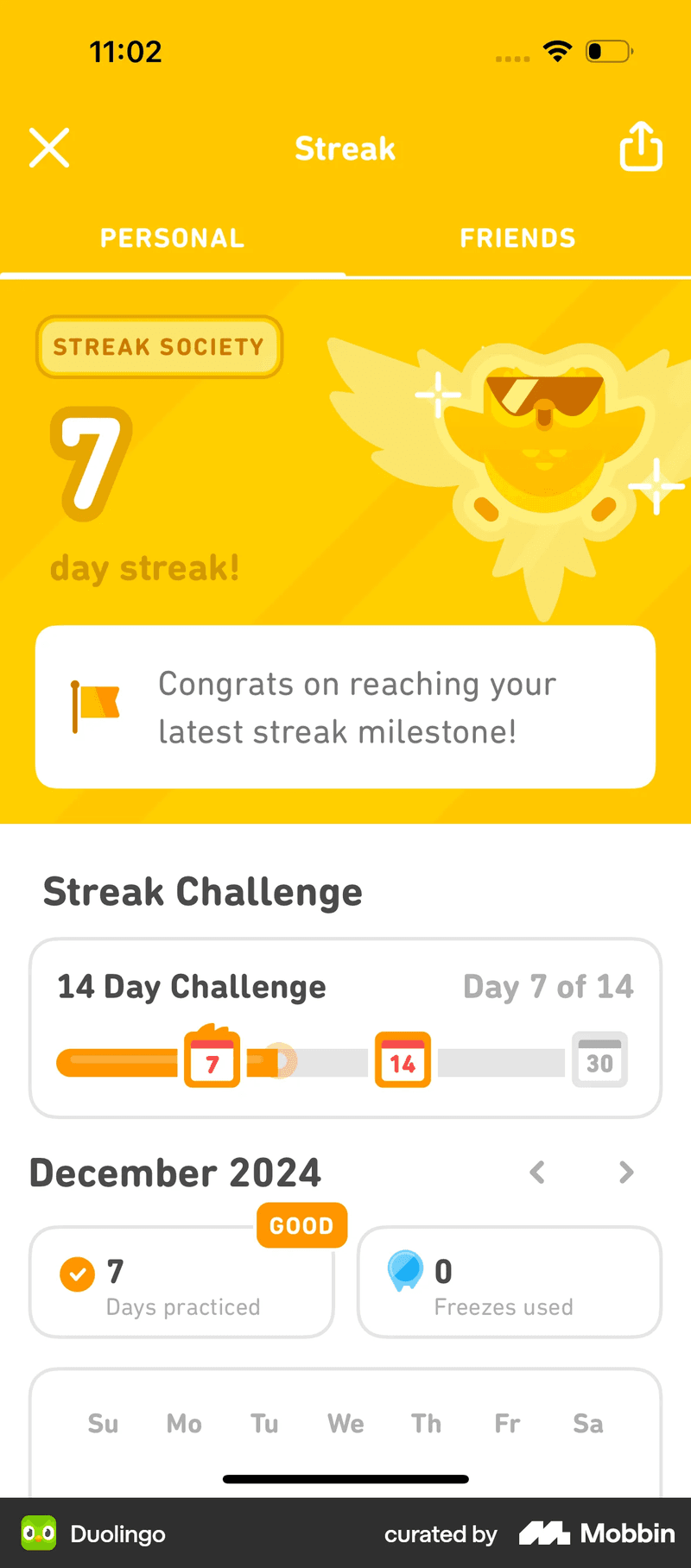
- XP Points: Reward every action (even small ones) to show progress and build momentum.
- Leaderboards: Tap into competitive instincts by letting users see how they rank.
- Heart system: Introduces a light penalty for wrong answers, adding challenge without being too punishing.
- Achievement badges & levels: Provide long-term goals that keep users working toward mastery.
What makes this work is that it turns learning into a habit loop: You show up, do something simple, get rewarded, and feel motivated to come back the next day. Plus, it’s all presented with playful visuals, sound effects, and encouragement that keeps it light and fun.
Other apps that apply similar gamified retention mechanics include Strava (for fitness), Todoist (with its Karma system), and Khan Academy (with mastery goals).
Spotify – Personalization to enhance engagement
Spotify is a masterclass in using personalized customer experience to keep users engaged. Their entire retention strategy is built around one simple idea: make every listening experience feel tailor-made.
Here’s how they pull it off:
- Daily Mixes & Release Radar. Auto-generated playlists based on listening behavior, so users always have something fresh (and familiar) to enjoy.
- Blend. Lets two users merge their music tastes into one personalized playlist, adding a social twist to personalization.
- Spotify Wrapped. A year-end recap that taps into nostalgia, pride, and social sharing.
- Quiz campaigns. Occasionally run interactive quizzes (e.g., “Which musical decade are you?”) to spark playful engagement and viral content.
What makes this work is how seamlessly it fits into the user journey. You don’t have to do anything to get personalization, but it’s always there, guiding you to your next favorite song or podcast.
This level of personalization is achievable in other verticals, too. Think about fitness apps (like 8fit) curating workouts based on your goals or learning apps (like Coursera) suggesting relevant courses.
Agoda – Contextual push notifications to drive conversions
Agoda doesn’t just ask users to book flights, it nudges them at exactly the right moment with contextual push notifications and in-app offers that drive urgency and action.
Here’s how they do it:
- Price-drop alerts. If you’ve searched for a hotel or flight and didn’t book, Agoda sends timely alerts when the price drops, re-engaging users with high intent.

- In-app flash deals. When users return to the app, they’re greeted with limited-time offers like “Book in the next 2 hours and get 10% off.” This creates FOMO and nudges instant decision-making.
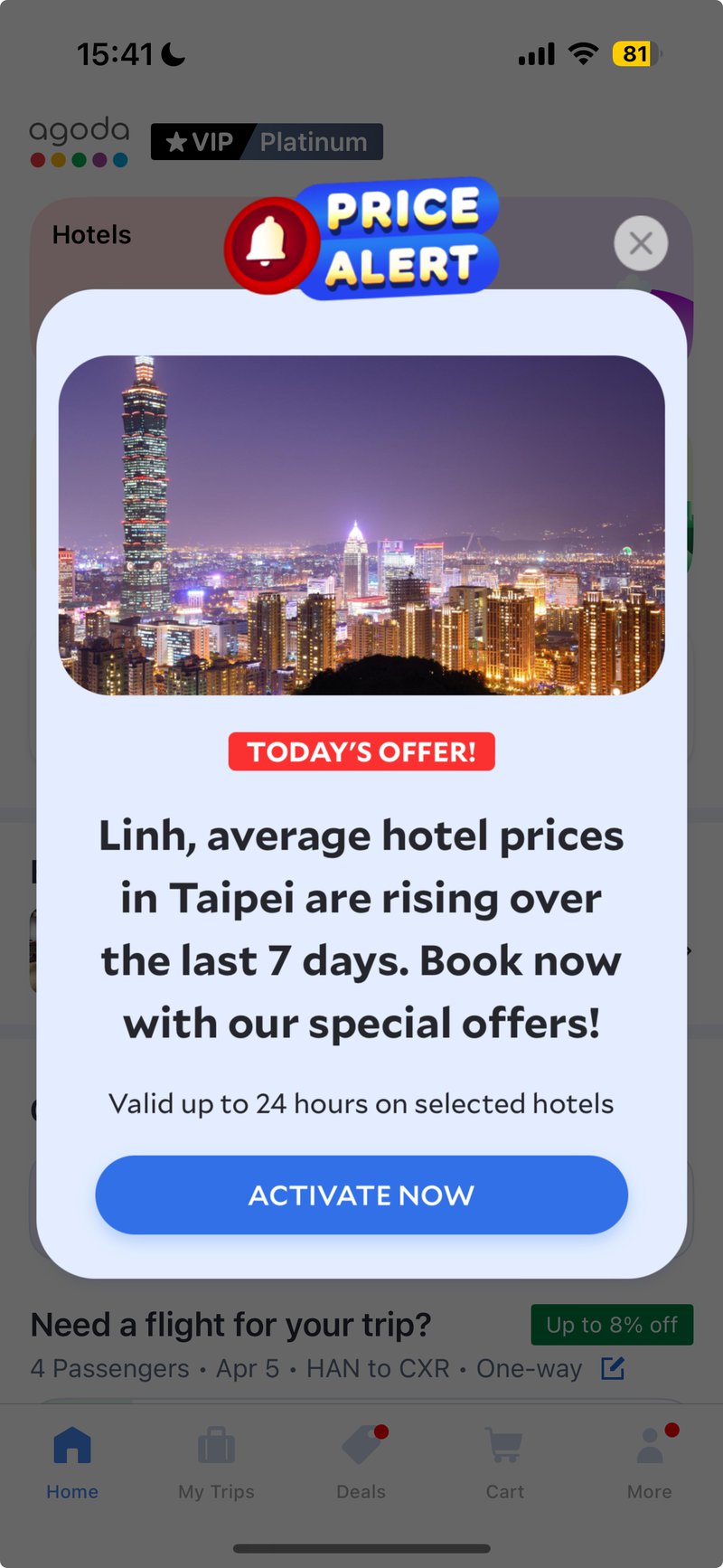
- Scarcity notifications. Messages like “Only 2 rooms left at this price!” tap into urgency and scarcity psychology to push conversion.
- Geo-targeted nudges. If a user is traveling or in a new city, the app might suggest last-minute deals nearby.
Agoda’s messaging works because they’re not just pushing messages; they’re responding to real intent signals.
This type of strategy works across many industries, whether you’re nudging users to complete an order, upgrade a subscription, or jump on a deal. And with Userpilot’s upcoming mobile push notification capabilities, you’ll be able to set up similar targeted nudges based on user behavior and segmentation.
Starbucks – Loyalty programs to drive repeat engagement
Starbucks has turned its mobile app into a loyalty engine. Their Starbucks Rewards program doesn’t just increase visits, it builds an ongoing relationship between user and brand.
Here’s how they pull it off:
- Stars-based rewards system. Every purchase earns stars, which can be redeemed for free drinks or food.
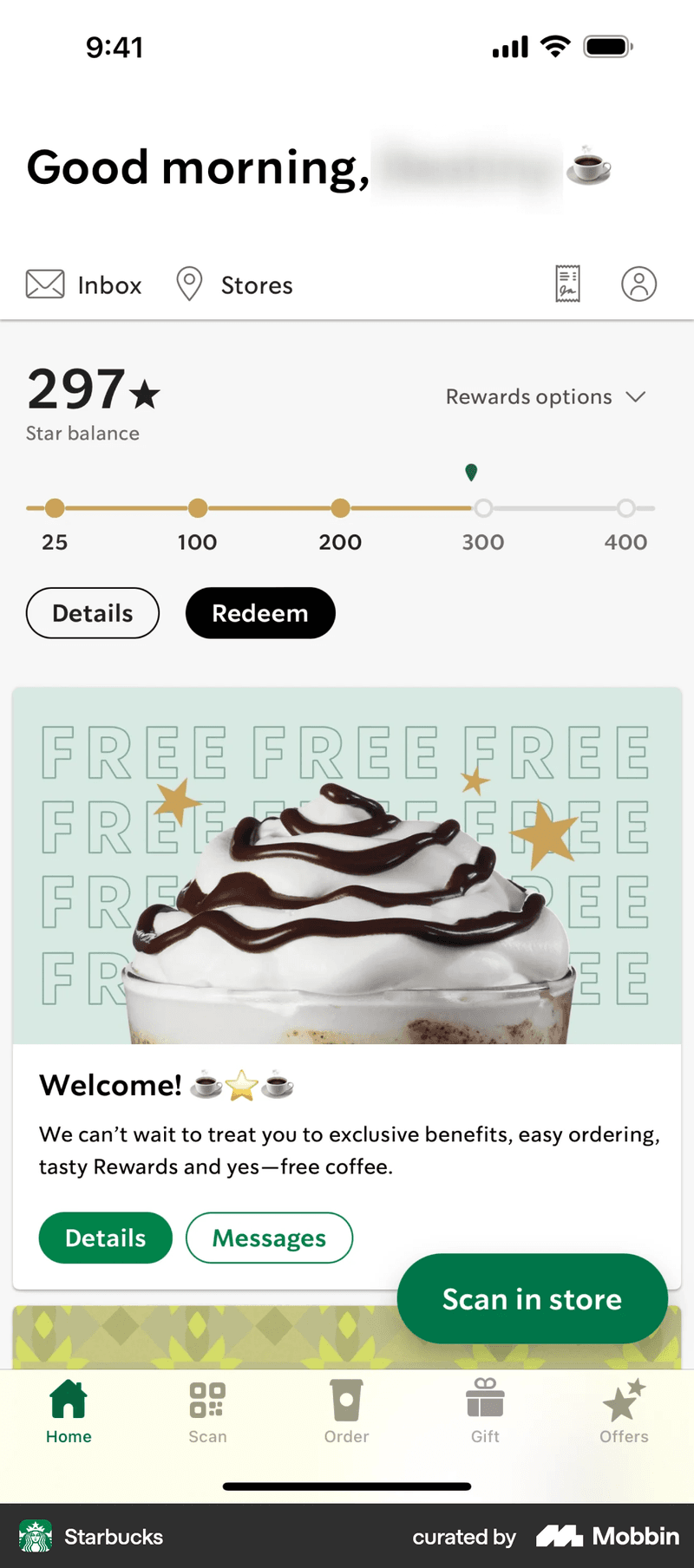
- Tiered membership levels. The more you spend, the more perks you unlock (including rewards from free birthday drinks to exclusive offers).
- Personalized promotions. Users get custom deals like “Double Star Days” based on their habits and preferences.
- Order ahead + mobile payments. Not strictly loyalty, but it makes earning and using rewards ultra-convenient, which reinforces usage.
It works because Starbucks isn’t just giving users rewards; they’re making it easy (and fun) to earn them, while subtly encouraging higher spending and more frequent visits.
Other apps in the food, retail, and travel space do something similar, like Dunkin’ Rewards, McDonald’s App, or Delta’s SkyMiles program, but Starbucks stands out for how tightly it integrates loyalty with everyday usage.
Enhance your mobile app retention with Userpilot!
Mobile app retention doesn’t just come by having a great product, you must work on it too.
The strategies we’ve covered all come down to one thing: creating continuous value for your users.
At Userpilot, we’ve seen firsthand how impactful it can be when mobile teams have the right tools to build and optimize these experiences, without waiting on dev resources.
“The mobile functionality is an amazing introduction and a key reason as to why we stayed.”
– Dean Lindsay – Product Marketing Manager at Third Bridge
So, if you’re ready to make retention a core part of your growth strategy and not just an afterthought, book a free Userpilot demo today to experience it yourself!
FAQ
What is a good retention rate for a mobile app? (*research)
It depends on the app category, but here are some general benchmarks for some industries:
- Productivity—2.7%
- Social—1.6%
- Travel—2.8%
- Shopping—4%
- Gaming—1.7%
- Finance—3.1%
- News apps—9.9%
What is the formula for mobile app retention rate?
Retention Rate (%) = (Active users at end of period ÷ Users at start of period) × 100
For example, if 1,000 users opened the app on Day 1, and 300 returned on Day 7, your Day 7 retention rate is 30%.
What does 80% retention rate mean?
It means 8 of every 10 users are still active after a certain time period (like Day 1, Day 7, etc.).
What is the lifespan of a mobile app?
It depends on the success of your app. If you consider that your average app has less than 3% retention rate, it’s easy to see why most of them don’t last long.
On the other hand, if your app is a market success, offers great onboarding, and provides ongoing value, then it can last years!

